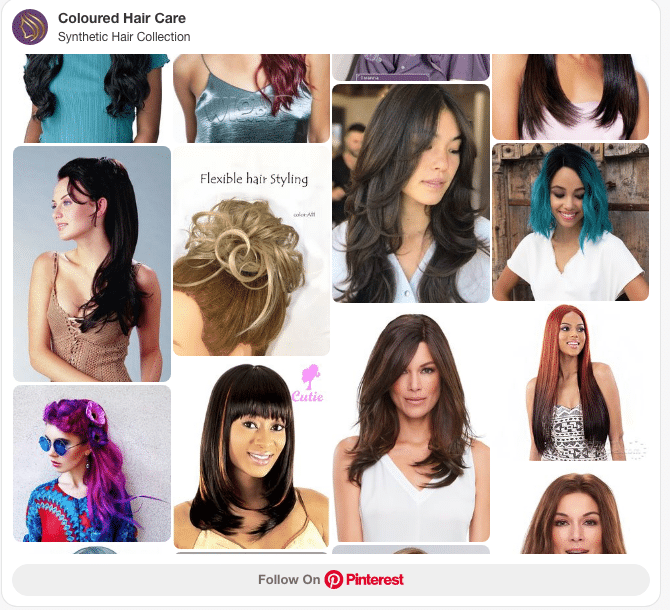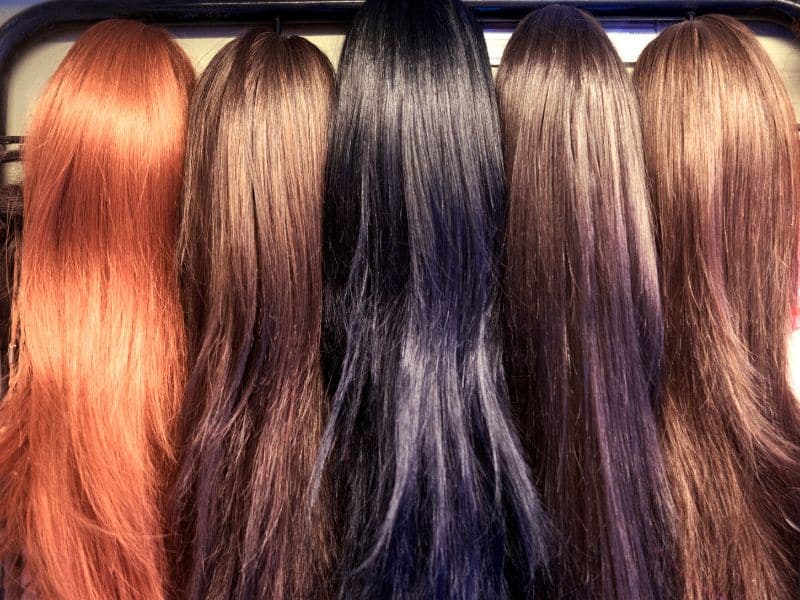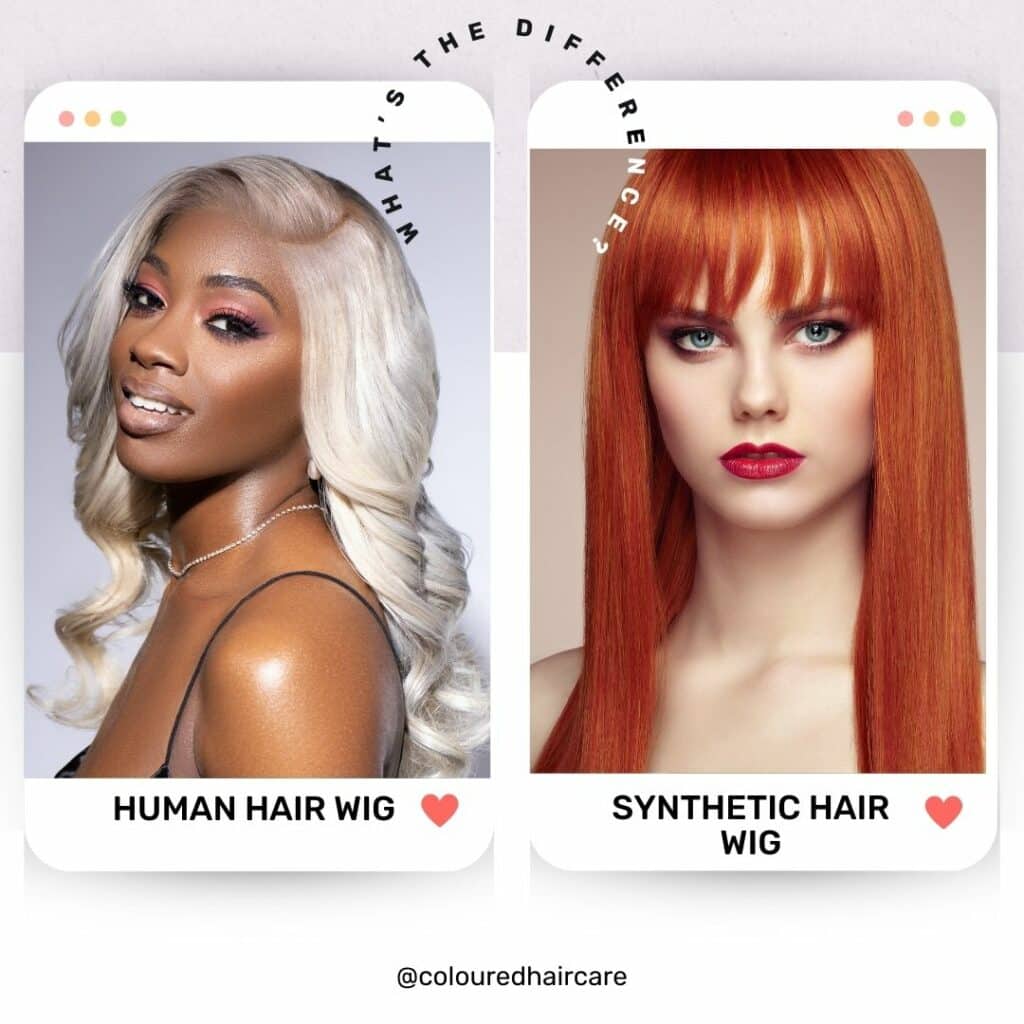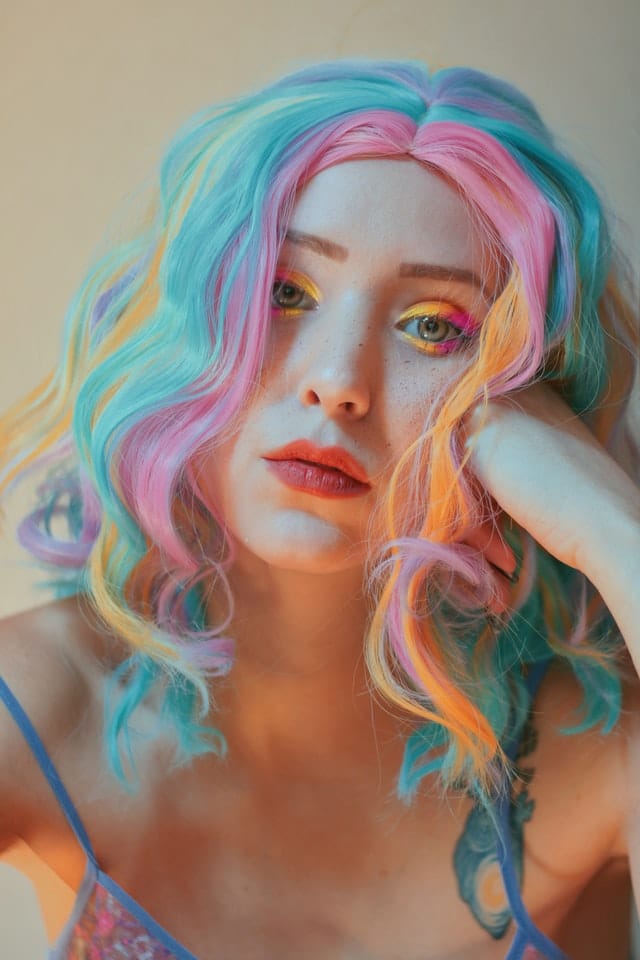Are you in love with the versatility of synthetic hair? Us too! Wigs and hair extensions are fantastic for experimenting with new styles or trialing a look before committing.
They add instant volume, length, and a dash of daring to your appearance. But here’s a question many wig enthusiasts ponder: Can you dye synthetic hair?
Wigs and hairpieces are a a fabulous, affordable solution for showcasing an array of temporary looks with ease.
But, what if you’re itching for a change? What if the latest trend has caught your eye, and you’re dreaming of transforming your chestnut brown locks into a stunning shade of midnight blue? Is it even possible with synthetic hair?
This article is a must-read for those who adore switching up their hair color without putting their natural tresses at risk.
Let’s find out all about synthetic hair and whether dyeing it is even a good idea.
Table of Contents
- What Is Synthetic Hair?
- Synthetic hair is great for:
- Can You Really Dye Synthetic Hair?
- How to dye synthetic hair (if you must!)
- Watch and learn: Which hair dye works best on synthetic wigs?
- Dyeing Synthetic Hair vs. Buying Colored Wigs
- What’s the difference between human hair and synthetic hair?
- Is human hair or synthetic better?
- Can you dye hair extensions?
- Can you dye synthetic hair with semi permanent hair dye?
- Can you use acrylic paint to dye a synthetic wig?
- Can you use temporary hair dye on synthetic hair?
- How long does synthetic hair last?
- How to care for synthetic hair
- Parting words.
What Is Synthetic Hair?
Synthetic hair, such as the wigs and extensions you’ve come to adore, is crafted from man-made fibers, offering a fantastic alternative to natural hair. But what exactly makes up these wiggy wonders?
What is synthetic hair made of?
Unlike natural hair, synthetic fibers are typically made from fine plastic filaments.
These fibers are engineered to mimic the texture and sheen of natural hair.
They react quite differently to dyes, heat, and styling, due to their plastic-based composition. This difference is crucial to keep in mind, especially when considering dyeing or styling it.
Types of Synthetic Hair
There are a few different types of synthetic hair. Popular types like Kanekalon and Toyokalon each have their unique properties.
Kanekalon is prized for its natural feel and flame-retardant quality, making it a top choice for wigs and extensions.
Toyokalon, on the other hand, tangles less and has a silkier texture but is less heat-resistant compared to Kanekalon. Understanding these nuances can help you make better decisions for your style and care routines.
Synthetic hairpieces are an excellent way to switch up your look without the commitment or damage to your natural hair.
But knowing their makeup and types is the first step in mastering their care and understanding whether doing things like dyeing them is even possible.
Check out the latest synthetic hair looks on our Pinterest board for ideas and inspiration.

Synthetic hair is great for:
- Adding volume and length with hair extensions.
- Wearing a new look for a big occasion.
- Trying out a new hairstyle or color.
- Easy to style and care for.
- Returns to shape after it gets wet.
- Less expensive than human hair wigs.
- Cooler to wear than human hair wigs.
Expert Insights
Lexi Gilmore, Freelance Professional Hairdresser“There are people who love synthetic hair. I love them too, especially to wear them for theme parties or just to change my appearance.
PLUS they are affordable. I also enjoy wearing them on hot days because they don’t feel as stuffy as some hair wigs do.”
Can You Really Dye Synthetic Hair?
So, let’e explore whether giving your synthetic wig or extensions a color makeover is a yay or a nay.
The Possibility and Limitations
The truth is, dyeing synthetic hair isn’t as straightforward as dyeing natural hair.
Wig experts Instant Arewa Hair tell us that, “Synthetic hair fibers are usually nylon or acrylic, meaning that they can’t absorb normal hair dye. So you’ll have to use dyes made for fabrics.”
So while it’s technically possible, there’s a big “but” attached.
Synthetic hair is made from plastic fibers, and these fibers don’t play well with regular hair dye.
The process isn’t just about slapping on some color; it’s a delicate dance that comes with its own set of rules and risks.
Risks Involved in Dyeing Synthetic Hair
Dyeing synthetic hair without knowing the risks could lead to a hair catastrophe.
Think unexpected colors (not always in a good way), damaged fibers, or even a completely ruined wig.
Why? Because synthetic fibers react unpredictably to chemical dyes. Plus, the heat often needed to set the dye can be too harsh, causing the hair to lose its texture and sheen.
In short, while there’s a slim chance of success, dyeing synthetic hair often feels like walking a tightrope without a safety net.
You might be aiming for a cool new shade, but end up with something that looks like it’s been through a hedge backwards.
But hey, don’t lose heart! If you’re really set on changing up your synthetic hair’s color, there are some safer alternatives and methods you can explore.
Expert Insights
“Dyeing a wig, particularly a synthetic one, can be a complex process, but it’s definitely achievable with the right tools and techniques.”
Luvme Hair, Wig Retailer

How to dye synthetic hair (if you must!)
We don’t recommend dyeing your synthetic wig or hair extension, but if you’re determined to go ahead with it, here’s a few tips on how to do so.
Preparing for Dyeing Synthetic Hair
Before you start transforming your synthetic locks, there are a couple of crucial steps to ensure you’re prepped and ready for the best results.
Conducting a Strand Test: Always start with a strand test. This isn’t just a small step; it’s a giant leap towards making sure you don’t end up with a ruined wig.
Grab a small section of the hair and apply your chosen dye. This will give you a sneak peek into how the entire wig or extension will look post-dyeing and help you decide whether to proceed or not.
Choosing the Right Dye: When it comes to dyeing synthetic hair, regular hair dye won’t cut it. You need fabric dye – yes, the kind used for clothes.
Why? Because synthetic hair is essentially plastic fibers, and fabric dye is formulated to adhere to materials like this. It’s the key to getting any color to stick and show up on your synthetic hair.
The Wig Dyeing Process Step-By-Step.
For this project you’ll need: hair dye, gloves, a bowl, a brush, cling film and some old towels.
Once you have everything, it’s time to get started!
- Choose Your Fabric Dye: Pick a fabric dye that’s suitable for synthetic fibers. Remember, regular hair dye won’t work here.
- Mix the Dye: Follow the instructions on the dye package. Usually, it involves mixing the dye with hot water, but not boiling, as extreme heat can harm the fibers.
- Strand Test First: Before going all in, apply the dye to a small section of hair. This will give you an idea of the final color and let you decide if you want to proceed.
- Apply the Dye: Using gloves, apply the dye evenly across the hair. Use a brush or comb for a more uniform application.
- Set the Color: Allow the dye to set for the recommended time. Be patient and don’t rush this step.
- Rinse Thoroughly: Rinse the hair until the water runs clear, ensuring all excess dye is washed out.
You now have a dyed synthetic wig!
And Don’t Forget Some Post-Dyeing Care:
- Gentle Washing: Wash your newly dyed hairpiece gently using a mild shampoo. Avoid harsh rubbing or scrubbing.
- Air Dry: Let your synthetic hair air dry. Avoid using high heat tools like hairdryers.
- Regular Maintenance: Regularly comb and maintain your synthetic hair to keep it looking fresh and vibrant.
Just remember, if you’re not happy with the color, it’s far easier to just buy a new wig, weave or hair piece in the shade you want.
Watch and learn: Which hair dye works best on synthetic wigs?
Here’s a great video tutorial that tests RIT, Adore, Arctic Fox, Toner, and Box Haircolor to see which can dye a synthetic wig the best!
Dyeing Synthetic Hair vs. Buying Colored Wigs
When it comes to switching up the color of your synthetic hair, you’re faced with a decision: should you dye your current wig or buy a new one in your desired color? Let’s break down the pros and cons to help you make the best choice for your needs.
Pros and Cons of Dyeing Synthetic Hair:
- Pros:
- Customization: Tailor the color to your exact liking.
- Affordability: Often more budget-friendly than buying a new wig.
- Creativity: Lets you experiment with unique colors and blends.
- Cons:
- Complexity: The process can be tricky and time-consuming.
- Uncertain Outcomes: Results can be unpredictable.
- Potential for Wear: Dyeing can shorten the lifespan of your wig.
Pros and Cons of Just Buying A Colored Wig:
- Pros:
- Convenience: Simply purchase and wear, no dyeing needed.
- Variety: Wide range of colors and styles readily available.
- Reliability: Consistent color and quality.
- Cons:
- Cost: Can be more expensive than dyeing an existing wig.
- Limited Customization: You’re restricted to available colors and styles.
- Storage: Requires space if you own multiple wigs.
Your decision will likely depend on your budget, the specific color you’re after, and how much time and effort you’re willing to invest.
If you love DIY projects and have a specific shade in mind, dyeing your synthetic hair could be a fun and satisfying experience. However, if you prefer convenience and guaranteed results, purchasing a new colored wig might be the way to go.
In the end, whether you choose to dye or buy, both options have their benefits. It’s all about what works best for you.
What’s the difference between human hair and synthetic hair?
What’s the difference between human hair and synthetic? We’re going to break it down for you.
Human hair is made from real hair, while synthetic is manufactured in a lab.
Synthetic hair can be used as a cheaper alternative to human hair, but it also has some disadvantages.
In general, human hair is more durable and realistic looking than man-made hair. It mimics natural body movement better.
But if you have an allergy or sensitivity to animal products, synthetics are your best bet!

Is human hair or synthetic better?
Hair is a part of our identity and it’s important for us to wear the hair that we feel most confident in.
But, there are many different things to consider when deciding if synthetic or human hair is best.
There are benefits and drawbacks to both types of hair.
Some people don’t like the plasticky look of synthetic strands while others can’t afford human hair because of the high cost.
Which type you choose will depend on your personal preference as well as what you need from your wig (or extensions) such as volume, color and length.
If you want to regularly dye your wig or extensions then human hair will be better for you.
It’s more durable and lasts longer, but it does take more upkeep.
They are both great options that have advantages and disadvantages.
The best thing you can do is try out different hairpieces for yourself and find the right one for your look and lifestyle.
Can you dye hair extensions?
Hair extensions are a great way to get the fullness and length of your desired hairstyle without having to wait for your natural hair to grow.
But can you dye synthetic ones? Again, the answer is yes, but we wouldn’t recommend it! The color in regular hair dye just won’t penetrate the synthetic fibres.
You’ll just end up with raggedy, ruined extensions so don’t try it! Far better to invest in some more hair extensions colored how you like.
Start a collection! Who doesn’t need to change up their look once in a while!
Fake hair extensions are also fabulous for adding a pop of color or colored hair streaks to your look.
And they work so well if you want to experiment with underneath hair color or peekaboo styles without the commitment of dyeing your hair.
Can you dye synthetic hair with semi permanent hair dye?
You might think that using a strong dye like a permanent hair dye might coat your wig in color – wrong!
Hair dye needs to be able to penetrate the hair to change it’s color. It can’t penetrate synthetic fibres.
Even semi-permanent hair dye still needs to penetrate the hair cuticle to change the color of the hair strand – and this can’t happen with man-made materials!
Can you use acrylic paint to dye a synthetic wig?
If you are feeling artistic, you can use acrylic paints and sharpie pens to permanently change the color of your wig.
This works best if you have a light colored wig like blonde or platinum.
Be warned, this is a messy job! And if you don’t get it right, it will ruin your wig.
Here’s a great video that shows you the process if you’re feeling brave enough!
Can you use temporary hair dye on synthetic hair?
Now, here is where you might have some success. Using temporary hair dye can work if you use it wisely.
Temporary hair colors come in the form of hair chalk, hair make-up sprays and temporary dyes. You can even use tissue paper! (but this method won’t work well on synthetic materials!).
They work by coating the hair with color and can be easily washed off.
They won’t permanently alter the color of your fake hair, but there are ways to use it to spice things up.
We wouldn’t recommend trying to change the all-over color of your hairpiece, extensions, weave or wig with temporary hair color.
But you can play around with adding highlights, streaks, dipped ends or ombre looks for sure.
Try face-framing highlights around your fringe and hairline.
Natural colors will be hard to get right and look natural. Use bright pops of color to make it fun.
How long does synthetic hair last?
How long do synthetic wigs last? The lifespan of a wig depends largely on how often you wear it and the quality of the material it’s made from.
A good synthetic wig can comfortably last between 4-6 months when worn every day, while bad ones might only survive 1 to 2 weeks with regular use before starting to fray and look tattered!
One common problem associated with these types of weaves is tangling which affects their daily resilience.
Combing them out before, during and after you use them really helps to keep their shape.
They tend have a shorter lifespan than human hair wigs as they are prone to tangling after some time.
How to care for synthetic hair
Maintaining your synthetic hair properly is key to keeping it looking fabulous for as long as possible. Here’s how to care for it and avoid common pitfalls:
Wig Maintenance Top Tips:
Wig specialists ProHair Labs recommend looking after your wig by:
- Gentle Washing: Use a mild shampoo and cool water to wash your synthetic hair. Hot water can damage the fibers.
- Avoid Heavy Products: Steer clear of heavy styling products like gels and mousses which can weigh down synthetic hair.
- Regular Detangling: Gently comb your wig or extensions with a wide-tooth comb or a brush made for synthetic hair to prevent tangling and matting.
- Proper Storage: Store your synthetic hair on a wig stand or in a silk or satin bag to maintain its shape and prevent tangles.
- Avoid Heat Styling: Synthetic hair isn’t as heat-tolerant as human hair. If you must style with heat, use the lowest setting and heat-protectant products.
Avoid These Common Mistakes.
Wig community Simply Wigs recommends these top tips:
- Sleeping or Showering in Wigs: This can cause tangling, matting, and overall wear. Remove your wig before bedtime or showering.
- Overwashing: Washing synthetic hair too often can lead to quicker deterioration. Wash only when necessary.
- Neglecting Care: Just like natural hair, synthetic hair needs regular care. Neglecting maintenance can lead to a shorter lifespan for your wig or extensions.
- Using the Wrong Tools: Avoid using brushes and combs meant for natural hair which can be too harsh. Opt for tools designed for synthetic hair.
By following these tips and avoiding these common mistakes, you can ensure that your synthetic hair remains as stunning as the day you got it
Parting words.
Regardless of whether you are looking to experiment with a new style or just want some extra volume, synthetic hair is an easy and affordable way to get the look that you desire.
The great thing about wigs is that they’re easy enough to take on and off when experimenting with different looks.
You can use them as wigs, clip-ins, and more. But before you go out of your way to buy some fun and funky wigs online, make sure they have been tested for safety first!
While it’s rare that anyone has an allergic reaction to these materials, there’s always a chance they could not agree with you!
We hope we’ve helped answer some questions about how synthetic material behaves. Now go out there and get experimenting! Good luck!
